|
|
|
| |
Ibike
Korea People-to-People Program
|
| |
|
| |
|
|
|
 Photo essay: Seongsan
to Daejeong Photo essay: Seongsan
to Daejeong
|
|
|
(90km, 56mi)
Points of Interest: Sunrise Peak, Seongeup Folk Village, Film Museum, World Cup
Stadium, Sculpture Peak |
| |
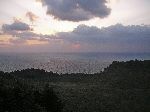 |
It is a ritual to climb Sunrise peak in
the morning to watch the sunrise. Clouds on the
horizon made the sun work pretty hard to make an appearance this day. |
| |
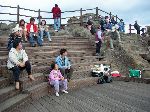
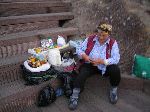 |
A good size group made it
up the mountain on this day to watch the sunrise. My favorite part of the
experience was a woman who arrived about a half-hour before any of the
others. She hauled a thermos of coffee, bottled water, energy drinks,
snacks, film, batteries, etc, up the mountain. Besides selling her wares, she
took pictures of groups so everyone could be in the picture and assured people
that the sun would in fact rise this day, even if it was being temporarily
delayed by the clouds. |
| |
 |
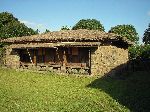 Traditional house on Jeju Island. Most
distinctive about the houses is their roofs. The roof is thatch, and then
the thatch is held down with ropes that criss-cross the roof. The roofs
are also very low profile -- no high peaks -- to give Jeju's famous wind less of
an opportunity to blow them away. There are a couple "folk villages" on
the island -- one was created specifically for tourist, and while it has good
interpretive information it is very sanitized. Traditional house on Jeju Island. Most
distinctive about the houses is their roofs. The roof is thatch, and then
the thatch is held down with ropes that criss-cross the roof. The roofs
are also very low profile -- no high peaks -- to give Jeju's famous wind less of
an opportunity to blow them away. There are a couple "folk villages" on
the island -- one was created specifically for tourist, and while it has good
interpretive information it is very sanitized. |
| |
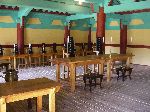 |
Confucian Seowan (shrine) at Seongeup traditional village, Jeju.
The memorial tablets commemorate past Confucian leaders in the community. They are placed in chairs set
before tables. |
| |
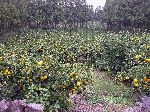 |
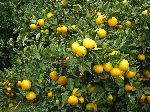 One of Jeju's claims to
fame is its orange crop. The orchards are planted in small sections
surrounded by taller trees that act as wind breaks. At harvest time the
trees are heavily laden with fruit (rignt). One of Jeju's claims to
fame is its orange crop. The orchards are planted in small sections
surrounded by taller trees that act as wind breaks. At harvest time the
trees are heavily laden with fruit (rignt). |
| |
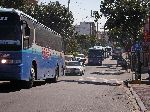 |
This is the middle of a caravan of about a dozen
tour buses -- it took me a while to get the camera out. I saw several
other caravans at least this long and one parade of buses about three times this
long. While it is better than move all these people in private
automobiles, the motorization of tourism on Jeju Island make it tougher to be a
non-motorized tourist. |
| |
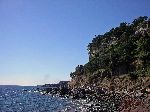 |
 The roughed (think hilly and picturesque) south
coast of Jeju Island (left). Seogwipo Harbor (right). The roughed (think hilly and picturesque) south
coast of Jeju Island (left). Seogwipo Harbor (right). |
|
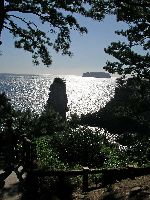 |
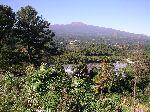 Oedolgae Rock
(left). Hallasan (1950m), the highest peak on Jeju (right). Oedolgae Rock
(left). Hallasan (1950m), the highest peak on Jeju (right). |
| |
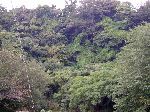 |
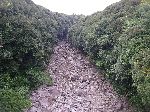 Last small patch of natural
camphor forest (left) -- mixed with many other species. Dry river bed ready for the next
typhoon rains (right). Last small patch of natural
camphor forest (left) -- mixed with many other species. Dry river bed ready for the next
typhoon rains (right). |
| |
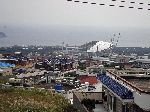
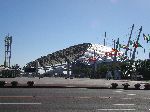 |
Jeju World Cup Stadium: Because legend and imagery
is so import in Korea and I had been steeped in it for several weeks, I love the
explanation of the symbolism in the design of the stadium that much more. "The
stadium itself is designed in the shape of an Orum - secondary volcanoes - found
all over Jeju Island. The roofs shape symbolizes Teu, traditional fishing
boats. The stadium's entrance represents Ollae and Jeongnang, which are
the entrance and gate of a traditional thatched-roof home. All these
things symbolize progressive spirit of Jeju's people sailing smoothly toward the
5 oceans and 6 continents in the 21st century... As an environmentally-friendly
stadium, the Jeju World Cup Stadium was built in harmony with the natural
environment. It is regarded as "the most beautiful stadium in the world"." |
| |
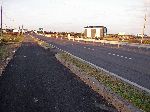 |
On the west end of the island, highway 12 doesn't
have as much traffic as in some other parts. For some sections there are
coast roads, which are an attractive options. But in rural areas the
highway is pretty good itself. |
| |
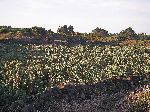 |
In a small section on the west end of the island
there were a number of prickly pear cactus farms. This cactus is
indigenous to the Americas, but it can be found in southern Europe and all
regions of Africa as well. |
| |
 |
The only factory I saw on Jeju Island. The
only good that I noted was manufactured on Jeju was toilet paper, but I could
determine if this factory was connected with that fact. |
| |
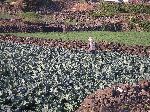 |
A farmer spray some chemical compound on her
cabbage patch. The wind was blowing enough to bring the smell to the road.
The farmer seem to be wearing only a cloth around her face for respiratory
protection. |
| |
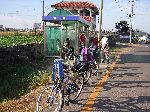 |
A group of older South Korea bicycle tourists.
They had come from Busan, rented bikes, and tied their bags on top of the rear
racks. I saw a few groups Korean cycle tourists on Jeju, but only when I
was on highway 12 -- they might be missing the best of the island. |
|
 |
Almost at the end of the journey, it time to start
thinking about souvenirs to buy. This factory on the outskirts of Jeju
City manufactures larger than life sculptures of Jeju's famous women divers --
if you would like a very unique souvenir to bring home for your front yard. |
|
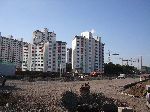 |
We made it full circle as we collided
with the west end of Jeju City expands out into the farm
land as half a dozen new high rises residential apartment buildings and a broad avenue. |
|
|
|
| |
Seongsan

 Seoul Seoul |
|
    |
 |
|
|
 Please
contact us if you would like to be added to
Ibike's mailing list or have questions, comments, corrections or criticism. (Also, please let us know how you learned about us and
found this site.) Privacy policy. Please
contact us if you would like to be added to
Ibike's mailing list or have questions, comments, corrections or criticism. (Also, please let us know how you learned about us and
found this site.) Privacy policy.
 IBF Homepage
IBF Homepage  Ibike Programs
Ibike Programs
 Ibike Schedule
Ibike Schedule
 Search
Search
"Hosted by
DreamHost - earth friendly web hosting"
Created by David Mozer
Copyright ?1993-2018 Ibike LLC. All rights reserved.
|
 Photo essay: Seongsan
to Daejeong
Photo essay: Seongsan
to Daejeong



 Traditional house on Jeju Island. Most
distinctive about the houses is their roofs. The roof is thatch, and then
the thatch is held down with ropes that criss-cross the roof. The roofs
are also very low profile -- no high peaks -- to give Jeju's famous wind less of
an opportunity to blow them away. There are a couple "folk villages" on
the island -- one was created specifically for tourist, and while it has good
interpretive information it is very sanitized.
Traditional house on Jeju Island. Most
distinctive about the houses is their roofs. The roof is thatch, and then
the thatch is held down with ropes that criss-cross the roof. The roofs
are also very low profile -- no high peaks -- to give Jeju's famous wind less of
an opportunity to blow them away. There are a couple "folk villages" on
the island -- one was created specifically for tourist, and while it has good
interpretive information it is very sanitized.

 One of Jeju's claims to
fame is its orange crop. The orchards are planted in small sections
surrounded by taller trees that act as wind breaks. At harvest time the
trees are heavily laden with fruit (rignt).
One of Jeju's claims to
fame is its orange crop. The orchards are planted in small sections
surrounded by taller trees that act as wind breaks. At harvest time the
trees are heavily laden with fruit (rignt).

 The roughed (think hilly and picturesque) south
coast of Jeju Island (left). Seogwipo Harbor (right).
The roughed (think hilly and picturesque) south
coast of Jeju Island (left). Seogwipo Harbor (right).
 Oedolgae Rock
(left). Hallasan (1950m), the highest peak on Jeju (right).
Oedolgae Rock
(left). Hallasan (1950m), the highest peak on Jeju (right).
 Last small patch of natural
camphor forest (left) -- mixed with many other species. Dry river bed ready for the next
typhoon rains (right).
Last small patch of natural
camphor forest (left) -- mixed with many other species. Dry river bed ready for the next
typhoon rains (right).








 Please
contact us if you would like to be added to
Ibike's mailing list or have questions, comments, corrections or criticism. (Also, please let us know how you learned about us and
found this site.) Privacy policy.
Please
contact us if you would like to be added to
Ibike's mailing list or have questions, comments, corrections or criticism. (Also, please let us know how you learned about us and
found this site.) Privacy policy.![]() IBF Homepage
IBF Homepage ![]() Ibike Programs
Ibike Programs
![]() Ibike Schedule
Ibike Schedule
![]() Search
Search


